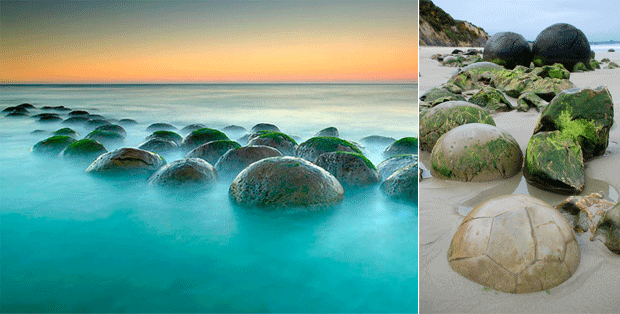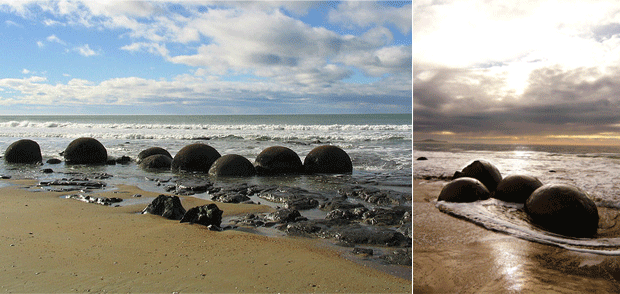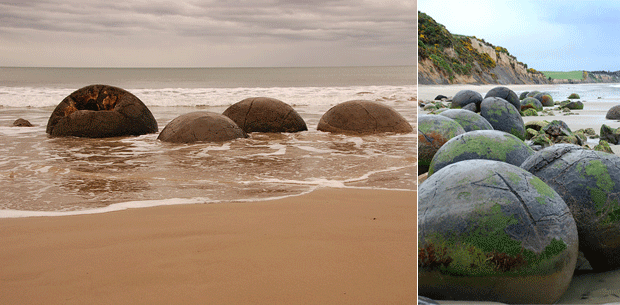|
If you go down to Koekohe beach in New Zealand you
can be sure of a big surprise. In front of you, scattered like enormous
marbles from some long abandoned game between giants, are hundreds of
giant spherical rocks. Or are they the egg shells of sea-born dragons?
The Moeraki boulders present us with a mystery – what are they and how
on earth did they get there?
Some are isolated but may occur in clusters. That they are here is the
result of three things – erosion, concretion and time. First the waves,
inexorable and patient, have pounded the local bedrock for countless
millennia. The mudstone on the beach – rock which was originally mud and
clay – is slowly but surely eroded. Underneath are the boulders that the
mudstone – in its original wet form, helped to form. However, the
boulders were not there to begin with – that came later.
Many of the Moeraki boulders give the impression of being completely
spherical – and they almost are. They are septarian concretions – a
sedimentary rock that has had the space between its individual grains
filled up by minerals which acted like cement. Concretions form inside
the layers of mud and clay and are not, as some think, boulders buried
over time.
|
|
 |
|
They do, however, tend to form early on in the history of the deposited
sediment – it is thought they occur before the rest hardens in to rock.
A consequence of concretion is that the resulting boulders are more
resistant to the weathering effects of the element. So, when the rest of
the sedimentary layers is eroded, the boulder (eventually) appears.
What is significant about these concretions is their size. They are big.
While not unique on the planet, some of them are up to a meter in
diameter but the majority range from 1.5 to 2.2 meters – that is almost
seven feet in diameter. Most of them are almost perfect spheres.
The material responsible for their concretion is a carbonate mineral
called calcite. In the center the concretion is sometimes quite weak
(perhaps the opposite we might expect) but the exterior is usually the
hardest part being made up of sometimes 20% calcite. Not only has the
calcite concreted the boulder’s clay and silt – it has replaced a lot of
it too.
|
|
 |
|
There are large cracks on the boulders and these are known as septaria.
The center of each boulder is hollow and the septaria radiate from
there. It is not really known what causes these septaria but they can be
filled up by several layers of calcite themselves and sometimes an
extremely thin layer of quartz.
The Moeraki boulders date from the Paleocene epoch which translates as
the early recent. In geological terms that may well be true, but that
means that the boulders are at least fifty six million years old. Our
own mammalian ancestors during that epoch were mostly small and rodent
like until late on.
|
|
 |
|
As you can imagine, there are many Māori legends concerning these hollow
boulders. One says that they are eel baskets that came ashore when a
large canoe was sunk. The reality is perhaps stranger than the legend.
Yet whenever they get visitors, there always has to be one!
|